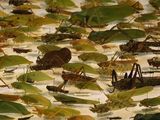How Many Animals Can Be Supported Naturally In An Area
Biodiversity
Biodiversity
Biodiversity refers to the variety of living species on Earth, including plants, animals, leaner, and fungi. While Globe's biodiversity is so rich that many species have yet to exist discovered, many species are being threatened with extinction due to homo activities, putting the Earth's magnificent biodiversity at risk.
Image
grasshoppers
Although all of these insects have a similar construction and may be genetic cousins, the beautiful variety of colors, shapes, camouflage, and sizes showcase the level of diversity possible even within a closely-related group of species.
Photograph past Frans Lanting

Biodiversity is a term used to draw the enormous diversity of life on Earth. Information technology can be used more specifically to refer to all of the species in i region or ecosystem. Biodiversity refers to every living thing, including plants, bacteria, animals, and humans. Scientists have estimated that at that place are around 8.7 one thousand thousand species of plants and animals in being. Notwithstanding, only around one.2 million species accept been identified and described so far, most of which are insects. This means that millions of other organisms remain a complete mystery. Over generations, all of the species that are currently live today have evolved unique traits that make them distinct from other species. These differences are what scientists use to tell one species from some other. Organisms that have evolved to be so different from i another that they can no longer reproduce with each other are considered different species. All organisms that tin reproduce with each other fall into one species. Scientists are interested in how much biodiversity there is on a global scale, given that at that place is yet so much biodiversity to discover. They likewise study how many species exist in single ecosystems, such as a forest, grassland, tundra, or lake. A single grassland tin comprise a wide range of species, from beetles to snakes to antelopes. Ecosystems that host the well-nigh biodiversity tend to have ideal environmental conditions for institute growth, similar the warm and moisture climate of tropical regions. Ecosystems tin can too contain species likewise minor to see with the naked eye. Looking at samples of soil or water through a microscope reveals a whole world of bacteria and other tiny organisms. Some areas in the world, such equally areas of Mexico, South Africa, Brazil, the southwestern U.s., and Madagascar, accept more than biodiversity than others. Areas with extremely high levels of biodiversity are called hotspots. Owned species—species that are merely found in 1 particular location—are also found in hotspots. All of the World's species work together to survive and maintain their ecosystems. For example, the grass in pastures feeds cattle. Cattle then produce manure that returns nutrients to the soil, which helps to grow more grass. This manure can also exist used to fertilize cropland. Many species provide of import benefits to humans, including nutrient, clothing, and medicine. Much of the Earth's biodiversity, even so, is in jeopardy due to homo consumption and other activities that disturb and even destroy ecosystems. Pollution, climatic change, and population growth are all threats to biodiversity. These threats have caused an unprecedented rise in the charge per unit of species extinction. Some scientists gauge that half of all species on Globe will be wiped out within the next century. Conservation efforts are necessary to preserve biodiversity and protect endangered species and their habitats.

Although all of these insects have a like structure and may be genetic cousins, the beautiful variety of colors, shapes, camouflage, and sizes showcase the level of diverseness possible even within a closely-related grouping of species.
Photograph by Frans Lanting
Substantive
all the dissimilar kinds of living organisms within a given area.
Noun
function of the Globe where life exists.
Noun
management of a natural resource to prevent exploitation, destruction, or fail.
consumption
Noun
process of using appurtenances and services.
diversity
Substantive
deviation.
Substantive
community and interactions of living and nonliving things in an surface area.
ecosystem diversity
Noun
number of ecosystems present in a specific area.
Noun
organism threatened with extinction.
endemic
Describing word
native to a specific geographic space.
evolution
Noun
change in heritable traits of a population over fourth dimension.
Noun
procedure of consummate disappearance of a species from World.
fertilize
Verb
to brand productive or fertile.
generation
Noun
time between an organism'south nascence and the time information technology reproduces.
genetic diversity
Noun
difference or variety of units of inheritance (genes) in a species.
hotspot
Noun
area that contains a meaning level of biodiversity and is threatened with destruction.
naturalist
Noun
person who studies the natural history or natural development of organisms and the environment.
Substantive
process by which organisms that are meliorate -adjusted to their environments produce more than offspring to transmit their genetic characteristics.
offspring
Noun
the children of a person or animal.
organism
Noun
living or in one case-living affair.
Noun
introduction of harmful materials into the environs.
reproduce
Verb
to create offspring, by sexual or asexual means.
Noun
group of similar organisms that tin reproduce with each other.
Noun
group of similar organisms that can reproduce with each other.
species diversity
Noun
formula that calculates the total number of specific species in an area compared with the number of all species.
trait
Noun
characteristic or aspect.
Source: https://www.nationalgeographic.org/encyclopedia/biodiversity/
Posted by: floressirche.blogspot.com

0 Response to "How Many Animals Can Be Supported Naturally In An Area"
Post a Comment